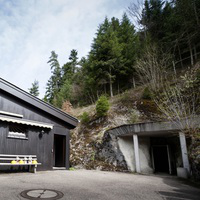The Black Forest Observatory (BFO) is a common joint facility of the Karlsruhe Institute of Technology (KIT) and the Universität Stuttgart. It has been jointly operated by the Geophysical Institutes and Geodetic Institutes of both institutions since 1971.
The Black Forest Observatory records several continuous geodynamic time series. Due to local conditions, they are of outstanding resolution for small signals in a global comparison. The site is frequently used by guest scientists from different countries for temporary experiments and benchmark tests for new sensors. Research projects at BFO study properties and possible improvements of geophysical observation methods and instruments, explore the elasto-gravitational free modes to enhance the understanding of the Earth's deep interior, and study long-period and aperiodic variations of gravity.
The Black Forest Observatory operates broad-band seismometers (STS-1 and STS-2), gravimeters (Superconducting gravimeter SG056, LaCoste Romberg earth-tide gravimeter ET-19), tiltmeters (Askania borehole tiltmeter, Horsfall fluid tiltmeter), three invar-wire strainmeters, magnetometers (GSM-90 Overhauser magnetometer, three Rasmussen fluxgate magnetometers), and a permanent GPS-station. These are supplemented by regularly repeated magnetic base-line measurements and observations of absolute gravity as well as the recording of several environmental observables (air-pressure, humidity, wind speed, precipitation, temperature). Some of the latter are used to correct geodynamic recordings for remaining disturbances. The data sets are published through international data centers (IRIS DMC at Seattle, SZO at the BGR in Hannover, Intermagnet in Edinburgh, GNSS data center at the BKG in Frankfurt, GGP-ISDC at the GFZ in Potsdam) for use by the public and researchers.
The observatory is located in the middle of the Black Forest far from potential sources of anthropogenic noise. Instruments are deployed in a former silver mine on virtually intact granite at depths of up to 170 m below the surface and at distances of up to 700 m from the entrance. The sites provide a very thermally stable environment. Two air-locks provide additional protection against air-pressure variations, and contribute to thermal stability.

